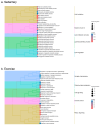Impact of Aerobic Training on Transcriptomic Changes in Skeletal Muscle of Rats with Cardiac Cachexia
- PMID: 40650303
- PMCID: PMC12249896
- DOI: 10.3390/ijms26136525
Impact of Aerobic Training on Transcriptomic Changes in Skeletal Muscle of Rats with Cardiac Cachexia
Abstract
Cardiac cachexia (CC) is an advanced stage of heart failure (HF) characterized by structural and functional abnormalities in skeletal muscle, leading to muscle loss. Aerobic training provides benefits; however, the underlying molecular mechanisms remain poorly understood. This study aimed to investigate the therapeutic effects of aerobic training on transcriptomic alterations associated with disease progression in cachectic skeletal muscle. HF was induced in male Wistar rats by a single monocrotaline injection (60 mg/Kg). Aerobic training consisted of 30 min treadmill running at ~55% of maximal capacity, 5×/week for 4 weeks. Assessments included body mass, right ventricle mass, skeletal muscle fiber size and exercise tolerance. RNA-seq analysis was performed on the medial gastrocnemius muscle. Sedentary cachectic rats exhibited 114 differentially expressed genes (DEGs) while exercised cachectic rats had only 18 DEGs. Enrichment pathways analyses and weighted gene co-expression network analysis (WGCNA) identified potential key genes involved in disrupted lipid metabolism in sedentary cachectic rats, which were not observed in the exercised cachectic rats. Validation of DEGs related to lipid metabolism confirmed that Dgat2 gene expression was modulated by aerobic training in CC rats. These findings suggest that aerobic training mitigates transcriptional alterations related to lipid metabolism in rats with CC, highlighting its therapeutic potential.
Keywords: exercise; metabolism; muscular remodeling; pulmonary arterial hypertension; transcriptome.
Conflict of interest statement
The authors declare no conflicts of interest.
Figures







Similar articles
-
Identification of a senescence-associated transcriptional program in skeletal muscle of cachectic pancreatic-tumor-bearing mice.Am J Physiol Cell Physiol. 2025 Apr 1;328(4):C1125-C1134. doi: 10.1152/ajpcell.00816.2024. Epub 2025 Feb 24. Am J Physiol Cell Physiol. 2025. PMID: 39993009 Free PMC article.
-
Bu-zhong-yi-qi decoction regulates JNK/c-JUN signaling pathway to improve skeletal muscle atrophy caused by cancer cachexia.J Ethnopharmacol. 2025 Jul 24;351:120078. doi: 10.1016/j.jep.2025.120078. Epub 2025 Jun 1. J Ethnopharmacol. 2025. PMID: 40460921
-
Late-Stage Skeletal Muscle Transcriptome in Duchenne Muscular Dystrophy Shows a BMP4-Induced Molecular Signature.J Cachexia Sarcopenia Muscle. 2025 Aug;16(4):e70005. doi: 10.1002/jcsm.70005. J Cachexia Sarcopenia Muscle. 2025. PMID: 40641092 Free PMC article.
-
Interventions for promoting habitual exercise in people living with and beyond cancer.Cochrane Database Syst Rev. 2013 Sep 24;(9):CD010192. doi: 10.1002/14651858.CD010192.pub2. Cochrane Database Syst Rev. 2013. Update in: Cochrane Database Syst Rev. 2018 Sep 19;9:CD010192. doi: 10.1002/14651858.CD010192.pub3. PMID: 24065550 Updated.
-
Physical exercise training interventions for children and young adults during and after treatment for childhood cancer.Cochrane Database Syst Rev. 2013 Apr 30;(4):CD008796. doi: 10.1002/14651858.CD008796.pub2. Cochrane Database Syst Rev. 2013. Update in: Cochrane Database Syst Rev. 2016 Mar 31;3:CD008796. doi: 10.1002/14651858.CD008796.pub3. PMID: 23633361 Updated.
References
-
- Bozkurt B., Ahmad T., Alexander K., Baker W.L., Bosak K., Breathett K., Carter S., Drazner M.H., Dunlay S.M., Fonarow G.C., et al. HF STATS 2024: Heart Failure Epidemiology and Outcomes Statistics An Updated 2024 Report from the Heart Failure Society of America. J. Card. Fail. 2025;31:66–116. doi: 10.1016/j.cardfail.2024.07.001. - DOI - PubMed
MeSH terms
Substances
Grants and funding
LinkOut - more resources
Full Text Sources
Medical
Research Materials
Miscellaneous

